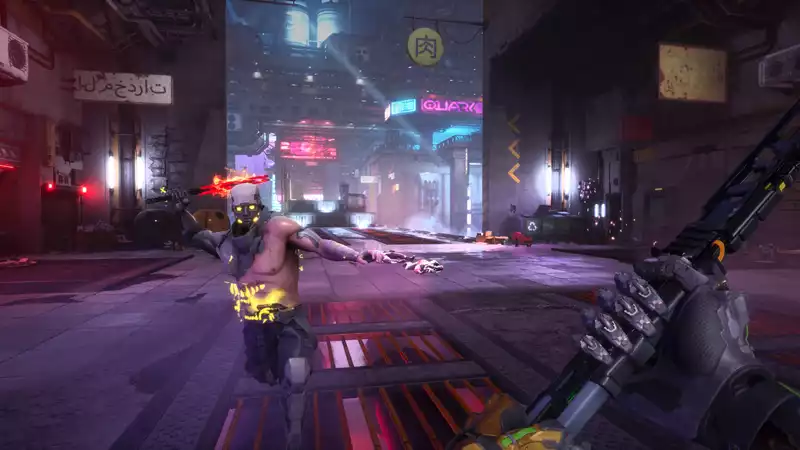The heart of the first game is still here, beating fast and loud. You still die with a single blow, and so do all the enemies except the bosses. The primary means of attack remains the sword, so whether the enemy hits you with a stick or disintegrates you from a distance with a laser, you'll have to get close to them and attack them directly. Fans of the original will feel at home, if not disappointed. The level section of Ghostrunner 2 is like a complex guitar solo. The performances of those who have mastered it are stupefyingly impressive, but your own attempts will be full of false starts and embarrassing failures.
Your character is fragile and will intentionally die repeatedly. Respawns occur instantly and death screens can be disabled. It's infuriating, sure, and sometimes even downright vicious. But it's not unfair. So far, it's a Ghostrunner. But Jack (the player-character) appears to be lagging slightly but noticeably behind compared to his first adventure. This turns out to be the first in a series of alarm bells.
"Ghostrunner 2" was an opportunity to trim the fat from what was already a good game in order to make something truly great. Instead, what we have here is a seven-hour game in a 14-hour jacket. Play time will vary depending on factors such as skill and determination to find collectibles, but the bottom line is that the extras keep getting in the way.
The first five hours or so take place in Dharma Tower, the setting of the first game. Appropriately, this early part of the film is where it feels closest to the original. The action is now interrupted for world-building and chats with friendly characters in between a few missions, but the parkour and gory combat are still in brutal, unrelenting harmony. Bouncing between walls, throwing yourself into bottomless pitfalls, and jumping from a hail of bullets after a few kills are as thrilling as ever. But when you eventually find a motorcycle, everything goes wrong.
If you played the demo and weren't impressed by the bike section that closes it out, it's unlikely to get any better. The main function of the bikes is to move from area to area through a disappointingly beige semi-open world. There are some neat ideas, such as jumping over laser gates while riding and getting back on the bike without slowing down, performing ranged and melee attacks while riding, riding along walls and ceilings, and then descending to the ground again, but none of them reach their full potential. There is one great motorcycle sequence, escaping from (and running through) a giant mechanical worm, which gives us a glimpse of what could have been. The problem with "Ghost Runner 2" in general, and the motorcycle sequence in particular, is that there is just too much of it.
Even outside the tower, it is not significantly less linear than in the first film. However, the environment is higher, wider, and more open. This means that problems that were rare but annoying in the original are now much more common and annoying. The number of jumps I've missed while playing is either hilarious or embarrassing, depending on how you look at it. That's fine, because it's part of the experience. But when I failed to reach a scaffold or wall and fell, I didn't die. Instead, I landed on an awkward landscape, and while I did not die, I could not return to the play area. My only option was to sheepishly jump to my death and restart from the last checkpoint.
Even ignoring the frame rate issues, which may be fixed by launch, I occasionally ran into technical problems that kept me from the experience. The upgrade machine was almost unusable except for the tower, and several times I fell off the world itself. The bike also presents a whole new opportunity to get stuck in a corner.
The clutter is very disappointing; Ghostrunner 2 is really good when it's good. The combat portion of the game can have a dozen or so enemies, but it's never less than satisfying when you finally get your strength back. As you start unlocking additional weapons and abilities, the element of choice comes into play, and a carefully judged shuriken throw or invisibility deployment could be the key to victory. In addition, there will be an Ultimate to help you out of a tight spot.
The parkour sections are not consistently enjoyable, but the best ones make you feel like the cybernetically enhanced badass that Ghost Runner hopes you are. Solving puzzles and making split-second decisions (it doesn't hurt to use your bullet-time abilities) while chaining together jumps and wall-runs is a real accomplishment.
And then there are the bosses, three of which are traditional single combatants, and you can expect a sword-smashing experience. None of them are as painfully difficult as the first one's most difficult (ugh, Hel), but they certainly put up a hell of a fight, and thanks to your fragile nature, victory feels incredibly well earned. The checkpoints are also wisely sprinkled throughout, so you won't be throwing your keyboard against the wall while screaming expletives you didn't know you were swearing.
This is a perfect example of the fact that quality and quantity are two very different things. This could have been an excellent game. Instead, too much of it is good, but too much of it is not.
.

Comments